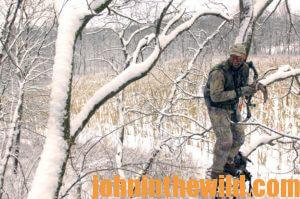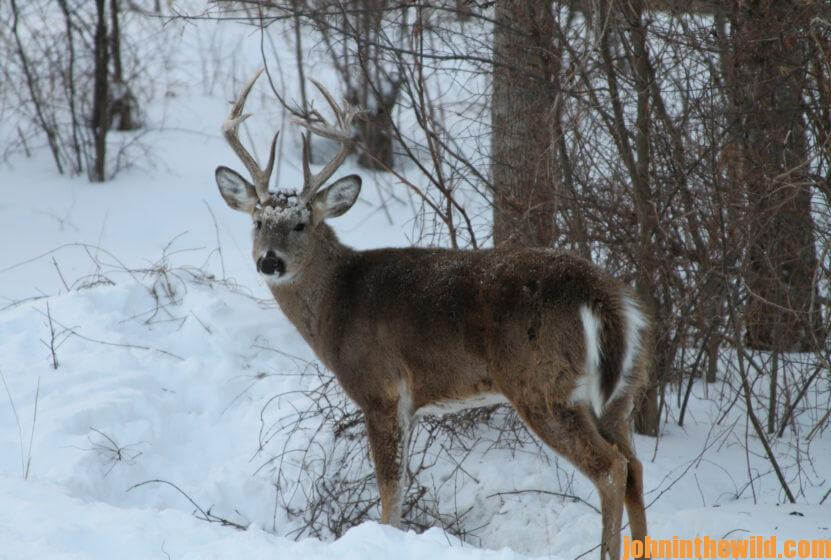Editor’s Note: Many of the nation’s leading bowhunters have developed strategies for successful deer hunting and have vast experience in scouting as well as bowhunting.
Cold weather can be a problem for bowhunters in late deer season. Often if a hunter sits still for some time, he’ll get so cold and be so stiff that when the deer presents a shot, either he won’t be able to shoot, or his fingers will be so cold that he either can’t feel the string or lets the string slip and misses the shot.
Thre e ingredients are critical to overcoming the elements during bad weather and still being able to arrow a deer. First of all, don’t sit for a long time in bad weather to try and bag a deer. Some bowhunters use a Trail-Timer (you often can find these for sale on the Internet and eBay), which can be strapped to a tree along the trail that the deer will take to come to the archer. When the deer bumps the string on the Trail-Timer, the Timer stops. After utilizing a Trail-Timer for two or three days, a hunter can predict at about what time deer will show up each day to feed. Other hunters prefer to check the times on their Trail cameras to learn this information. If the deer hunter will plan to be in his stand an hour before he thinks the deer will show up and remain there an hour after that, then he reasonably can expect to see the deer and have a shot within two hours of going to the stand. Although deer don’t feed at the same time all during the year, by knowing about when they feed, and where they feed, the hunter can reduce the number of hours he must spend in a tree stand, and thereby increase his effectiveness and his ability to bag dee r.
e ingredients are critical to overcoming the elements during bad weather and still being able to arrow a deer. First of all, don’t sit for a long time in bad weather to try and bag a deer. Some bowhunters use a Trail-Timer (you often can find these for sale on the Internet and eBay), which can be strapped to a tree along the trail that the deer will take to come to the archer. When the deer bumps the string on the Trail-Timer, the Timer stops. After utilizing a Trail-Timer for two or three days, a hunter can predict at about what time deer will show up each day to feed. Other hunters prefer to check the times on their Trail cameras to learn this information. If the deer hunter will plan to be in his stand an hour before he thinks the deer will show up and remain there an hour after that, then he reasonably can expect to see the deer and have a shot within two hours of going to the stand. Although deer don’t feed at the same time all during the year, by knowing about when they feed, and where they feed, the hunter can reduce the number of hours he must spend in a tree stand, and thereby increase his effectiveness and his ability to bag dee r.
The second ingredient needed to successfully take a whitetail during bad-weather conditions is to layer your clothing. In most instances, the hunter wears too-many or too-few clothes for bad weather. If the hunter has on too-many clothes, he actually may become hot and sweaty while walking to his deer stand. Then as his body cools down, he may get cold in his stand.
If an outdoorsman wears just enough clothes to stay warm on the way to his stand without sweating, then he’ll more than likely be shivering within 45 minutes to an hour after he’s in his stand. So, hunters should dress in several layers. Then they can take clothes off or put clothes on – depending on how hot they get going to their stands and while in their stands. If a hunter isn’t comfortable when he prepares to draw and shoot, more than likely he’ll miss the deer.
The third problem is how to keep the archer’s fingertips warm enough to feel the trigger on a mechanical release or the string on a bow. Many bowhunters use the small, instant hot packs that give off heat for 2 – 3 hours and keep hands and fingers warm and comfortable. Then when the time comes to make a shot, you’ll have all the sensitivity in your hands you need to shoot accurately.
If a hunter only can remain in a stand two or three hours and concentrate on hunting deer, then at the end of that two or three hours, he should leave the stand. One of the worst things a deer hunter can do is not pay attention while he’s in a tree stand.
 To learn more about hunting for deer, check out John E. Phillips’ bowhunting books, available in Kindle, “Bowhunting Deer: Mossy Oak Pros Know Bucks and Bows” (http://amzn.to/1QGvdQx) and “Bowhunting Deer: The Secrets of the PSE Pros” (http://amzn.to/VBr1qW).
To learn more about hunting for deer, check out John E. Phillips’ bowhunting books, available in Kindle, “Bowhunting Deer: Mossy Oak Pros Know Bucks and Bows” (http://amzn.to/1QGvdQx) and “Bowhunting Deer: The Secrets of the PSE Pros” (http://amzn.to/VBr1qW).
Tomorrow: Minimize Mistakes Made in a Tree Stand While Hunting Deer










